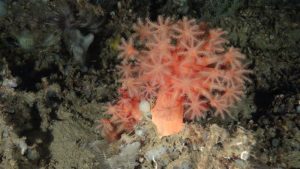
©NATGEO
El arrecife de Cabliers, en el sur del Mar de Alborán ha permanecido intacto hasta la fecha gracias a su aislamiento y su profundidad.
Este tesoro del Mediterráneo es uno de los arrecifes de coral de agua fría más grandes y densos del Mar Mediterráneo y también es el único del que hasta ahora, sigue creciendo en toda la cuenca.
El Cabliers es un ecosistema único que, hasta ahora, ha quedado a salvo de la acción humana, debido a su profundidad de entre 250 y 710 metros. Se encuentra en un afloramiento volcánico de 25 km de largo y su existencia fue conocida en 2011 por la ONG Oceana.
El arrecife está formado por corales pétreos (Lophelia pertusa) y Madrepora oculata, además de especies amenazadas, como gorgonias de profundidad, corales negros y esponjas cristal. Los investigadores han documentado un total de 500.000 metros cuadrados de coral vivo que es hoja para una gran biodiversidad de especies marinas, como el voraz, el congrio, la bacaladilla o la gallineta.
A diferencia de los corales tropicales, los de aguas frías no presentan colores brillantes, sino que son generalmente de tonos pardos o blanquecinos. Esto se debe a que, a esas profundidades no llega la luz del sol, condición imprescindible para que las algas puedan realizar la fotosíntesis. Algunas algas como las zooxantelas son responsables de la coloración de los corales tropicales, con los que establecen una relación simbiótica. Otra diferencia es, también, que recogen los nutrientes que se generan más arriba y que caen al fondo del mar. Ello depende de los restos de animales muertos que se precipitan desde las capas superiores de la columna de agua. También explica que los pólipos se distribuyan a lo largo de lugares estratégicos, aprovechando las corrientes marinas.
Con todo ello, el arrecife de Cabliers es un laboratorio natural que ofrece información sobre cómo se han adaptado o han evolucionado a lo largo del tiempo, en una situación privilegiada dentro del océano por estar fuera del alcance de la acción humana.
__
The Cabliers reef in the southern Alboran Sea has remained intact to date thanks to its isolation and depth.
This Mediterranean treasure is one of the largest and densest cold-water coral reefs in the Mediterranean Sea and is also the only one that, so far, is still growing in the entire basin.
The Cabliers is a unique ecosystem that, until now, has remained safe from human action, due to its depth of between 250 and 710 meters. It is located on a 25 km long volcanic outcrop and its existence was made known in 2011 by the NGO Oceana.
The reef consists of stony corals (Lophelia pertusa) and Madrepora oculata, as well as threatened species such as deep sea gorgonians, black corals and glass sponges. Researchers have documented a total of 500,000 square meters of living coral that is a foil for a great biodiversity of marine species, such as vorax, conger eel, blue whiting and redfish.
Unlike tropical corals, cold water corals are not brightly colored, but are generally brownish or whitish. This is due to the fact that sunlight does not reach these depths, an essential condition for algae to photosynthesize. Some algae such as zooxanthellae are responsible for the coloration of tropical corals, with which they establish a symbiotic relationship. Another difference is that they collect nutrients that are generated further upstream and fall to the bottom of the sea. This depends on the remains of dead animals that precipitate from the upper layers of the water column. It also explains why the polyps are distributed along strategic locations, taking advantage of marine currents.
All in all, the Cabliers reef is a natural laboratory that provides information on how they have adapted or evolved over time, in a privileged situation in the ocean, out of reach of human action.74.
__

